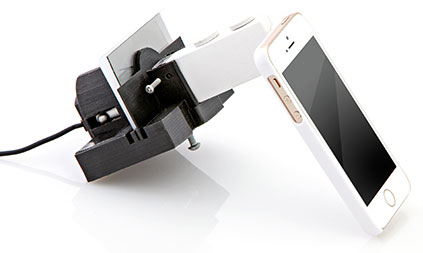 Researchers at Texas A&M University have developed a novel point-of-care device for field-based diagnosis of malaria using a smartphone. The mobile-optical-polarization imaging device (MOPID) attaches to smartphones or tablets and co-opts the camera to detect birefringent hemozoin in histological samples, which is indicative of malarial infection.
Researchers at Texas A&M University have developed a novel point-of-care device for field-based diagnosis of malaria using a smartphone. The mobile-optical-polarization imaging device (MOPID) attaches to smartphones or tablets and co-opts the camera to detect birefringent hemozoin in histological samples, which is indicative of malarial infection.
Despite advances in diagnostic approaches and treatment, malaria remains one of the leading sources of disease and death in developing nations. The “gold standard” of detection, evaluation of Giemsa-stained blood smears via bright-field microscopy, often requires skilled technicians and laboratory environments that are few and far between in the regions that are most in need. Even when available for field-testing, white light microscopy tends to report many false positive diagnoses as well. Bench-top polarized light microscopy systems, while more definitive, are large, expensive pieces of equipment that are complex to operate, and to maintain as well.
The MOPID, though, appears to offer a highly-mobile and effective alternative, at a cost that should be palatable in underserved countries. The device in its current form has demonstrated imaging properties that compare favorably with a reference Leica DMLM polarized microscope – a resolution of 1.05 μm, system magnification in the range of 50x, and field of view measuring 0.78 mm x 0.79 mm.
Going forward towards release and dissemination of the technology, the group is currently concentrating on preparing units for in vivo field-testing in Rwanda. To do so, they will be taking efforts to lower the physical profile of the device, improve upon human factors engineering and user-interface components, and lower costs. The ultimate vision is for each MOPID diagnostic test to be priced under $1.00 per result, anywhere in the world.
The MOPID device marks another in a series of recent mobile device imaging innovations that are empowering clinicians and researchers without access to traditional acquisition tools (see our recent post on the smartphone-powered D-EYE Digital Ophthalmoscope or read about technology pioneer Jonathan Rothberg’s plan to bring ultrasound to mobile devices).
Study in Scientific Reports: Malaria Diagnosis Using a Mobile Phone Polarized Microscope…
The post Modular Add-On Brings Polarized Light Microscopy, Malaria Diagnosis to Smartphones appeared first on Medgadget.
